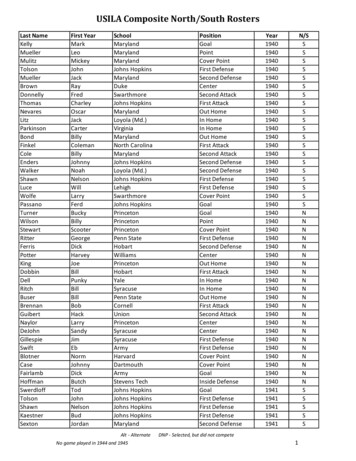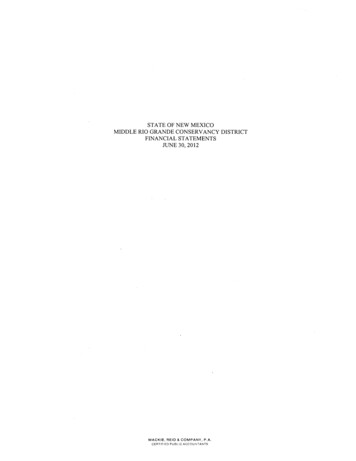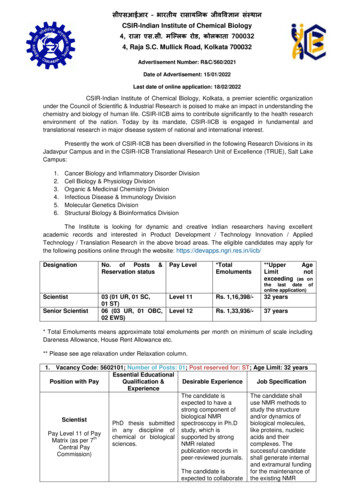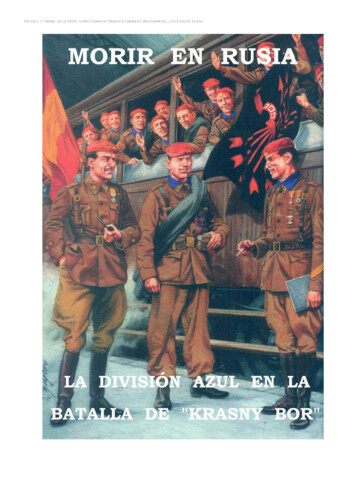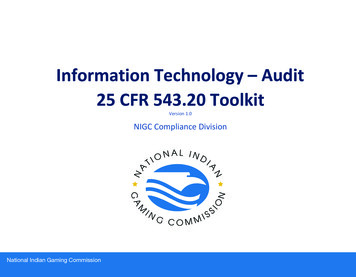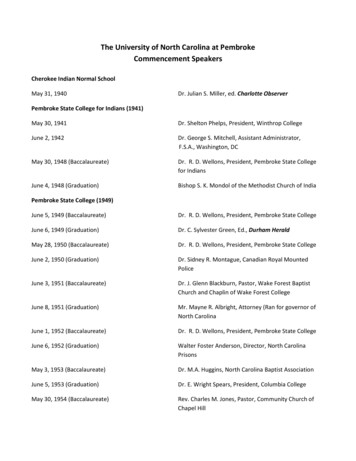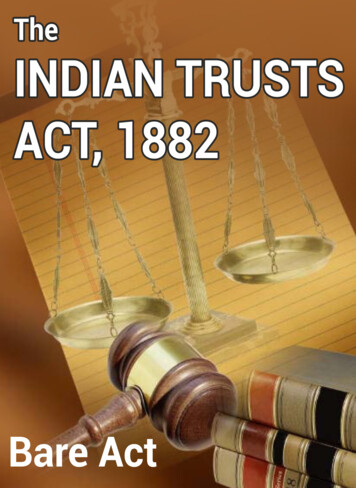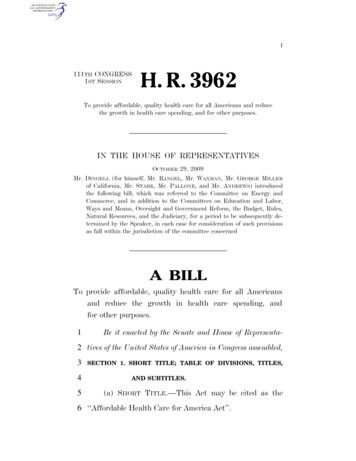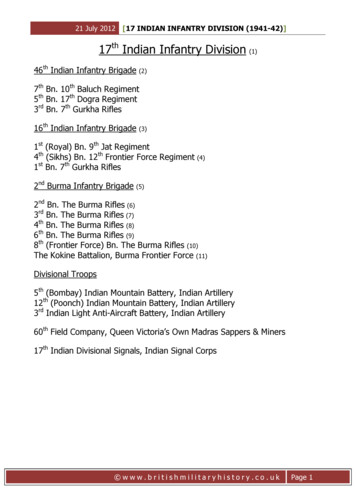
Transcription
21 July 2012 [17 INDIAN INFANTRY DIVISION (1941-42)]17th Indian Infantry Division (1)46th Indian Infantry Brigade(2)7th Bn. 10th Baluch Regiment5th Bn. 17th Dogra Regiment3rd Bn. 7th Gurkha Rifles16th Indian Infantry Brigade(3)1st (Royal) Bn. 9th Jat Regiment4th (Sikhs) Bn. 12th Frontier Force Regiment1st Bn. 7th Gurkha Rifles2nd Burma Infantry Brigade(4)(5)2nd Bn. The Burma Rifles (6)3rd Bn. The Burma Rifles (7)4th Bn. The Burma Rifles (8)6th Bn. The Burma Rifles (9)8th (Frontier Force) Bn. The Burma Rifles (10)The Kokine Battalion, Burma Frontier Force (11)Divisional Troops5th (Bombay) Indian Mountain Battery, Indian Artillery12th (Poonch) Indian Mountain Battery, Indian Artillery3rd Indian Light Anti-Aircraft Battery, Indian Artillery60th Field Company, Queen Victoria’s Own Madras Sappers & Miners17th Indian Divisional Signals, Indian Signal Corps www.britishmilitaryhistory.co.ukPage 1
21 July 2012 [17 INDIAN INFANTRY DIVISION (1941-42)]NOTES:1. This formation, later to become famous as the ‘Black Cat’ Division, was formed inAhmednager on 1st July 1941 as a War Office reserve division. It moved to Dhond fortraining in November 1941, and officially mobilised on the 1st December 1941. At thattime, it consisted of three brigades, the 44th, 45th and 46th Indian Infantry Brigades. Itwas intended to send the division to Iraq for training and equipping as a fullymechanised division for desert warfare. However, the 44th and 45th Brigades weredispatched to Singapore in early 1942 where they fought in lower Malaya andSingapore. Both brigades were destroyed during the fighting, with the survivors beingcaptured with the fall of Singapore in February 1942. The divisional headquarters and46th Brigade were sent to Burma in January 1942 and established its headquarters atMoulmein. It assumed command of the troops in southern Burma.2. The brigade arrived in Burma in early January 1942 as part of the 17th Division.Deployed to the Bilin area. The 46th Brigade, commanded by Brigadier R. G. EKIN,comprised three war raised service battalions, the 7th Bn. 10th Baluch Regiment(Lieutenant Colonel DYER) 5th Bn. 17th Dogra Regiment (Lieutenant Colonel POWER)and 3rd Bn. 7th Gurkha Rifles (Lieutenant Colonel STEVENSON).3. This brigade was initially under the command of the 7th Indian Division in India. It wassent to Burma, arriving from India in November 1941. It came under command of 17thIndian Division when the division arrived in Burma and was deployed in the Dawna andKawkariek areas. The brigade comprised three regular Indian battalions.4. The battalion transferred to 2nd Burma Brigade in January 1942. It was replaced by:4th Bn. The Burma Rifles5. This brigade transferred from 1st Burma Division in January 1942 with the arrival of17th Division, which assumed command of all the troops in Southern Burma. Theformation was based in Moulmein.6. The battalion was deployed in Mergui. It was evacuated by sea to Moulmein betweenthe 20th and 22nd January 1942.7. The battalion was deployed in Moulmein, with two companies detached to Tavoy.These two companies disintegrated when attacked, with the remnants retreating toMoulmein.8. This battalion was located at Moulmein, then transferred to 16th Brigade and deployedto the Thai border. It was replaced in 2nd Brigade by: 4th (Sikhs) Bn. 12th FrontierForce Regiment9. The battalion located at Tavoy. It disintegrated when attacked and ceased to exist asa fighting unit.10. Based in Moulmein.11. Based in Moulmein with detachments dispersed in the area.SOURCES:See Page 6 www.britishmilitaryhistory.co.ukPage 2
21 July 2012 [17 INDIAN INFANTRY DIVISION (1941-42)]17th Indian Infantry Division46th Indian Infantry Brigade(2)7th Bn. 10th Baluch Regiment4th (Sikhs) Bn. 12th Frontier Force Regiment3rd Bn. 7th Gurkha Rifles4th Bn. The Burma Rifles (4)16th Indian Infantry Brigade(3)(5)2nd Bn. The King’s Own Yorkshire Light Infantry1st (Royal) Bn. 9th Jat Regiment5th Bn. 17th Dogra Regiment (7)1st Bn. 7th Gurkha Rifles8th (Frontier Force) Bn. The Burma Rifles (8)48th Indian Infantry Brigade(1)(6)(9)1st Bn. 3rd Queen Alexandra’s Own Gurkha Rifles1st Bn. 4th Prince of Wales’s Own Gurkha Rifles2nd Bn. 5th Royal Gurkha Rifles (Frontier Force)Divisional Troops1st Bn. The West Yorkshire Regiment (The Prince of Wales’s Own)2nd Bn. The Duke of Wellington’s Regiment (West Riding) (11)2nd Bn. The Burma Rifles (12)(10)5th (Bombay) Mountain Battery, Indian Artillery12th (Poonch) Mountain Battery, Indian Artillery28th Mountain Regiment, Indian Artillery (13)(H.Q., 15th (Jhelum) & 28th Mountain Batteries, Indian Artillery)2nd Indian Anti-Tank Regiment, Indian Artillery(13)60th Field Company, Queen Victoria’s Own Madras Sappers and Miners24th Field Company, Royal Bombay Sappers and Miners (14)17th Indian Divisional Signals, Indian Signal Corps www.britishmilitaryhistory.co.ukPage 3
21 July 2012 [17 INDIAN INFANTRY DIVISION (1941-42)]NOTES:1. This is the order of battle for the 17th Indian Division at the Bilin River and SittangRiver battles. The 48th Brigade had arrived replacing 2nd Burma Brigade. In addition,two British battalions had arrived from India, both being thrown straight into thebattles.2. The brigade was deployed in the Kyaikto area, ie, behind 16th Brigade. This was toallow the Brigade to rest and reorganise following the initial contacts with the Japaneseforces at Moulmien.3. This battalion had been transferred to 2nd Burma Brigade, however, when that brigadewas withdrawn into L.o.C. on 11th February 1942, this battalion was transferred tocome under command 46th Brigade.4. The battalion had been transferred to 16th Brigade and deployed on the Thai border.When the Japanese attacked, the battalion was brought back from the border toMoulmein, and following the withdrawal from there, came under command of 46thBrigade.5. This brigade deployed to defend the Bilin River line.6. This battalion transferred from 1st Burma Brigade to assist in defence of Bilin River.7. This battalion transferred from 48th Brigade.8. This battalion was under command of 2nd Burma Brigade, but remained in area whenthe brigade posted away on 11th February 1942. It then came under command of the16th Brigade.9. The brigade (formerly under command of 14th Division in India) arrived in Burma on31st January 1942. It came under command of 17th Division as the reserve brigade.10. This battalion arrived in Burma on 25th January 1942, being deployed to Sittang areaunder command of 17th Division.11. This battalion arrived in Rangoon on 14th February 1942. It was immediatelydispatched to the front line where it was caught up in the Sittang River battle undercommand of 17th Division.12. This battalion was located in Papun.13. These regiments landed in Rangoon on 14th February 1942. Both had difficulty inreaching front line due to lack of transport.14. This company landed in Rangoon on 14th February 1942.SOURCES:See Page 6 www.britishmilitaryhistory.co.ukPage 4
21 July 2012 [17 INDIAN INFANTRY DIVISION (1941-42)]17th Indian Infantry Division46th Indian Infantry Brigade(2)16th Indian Infantry Brigade(3)‘A’ Battalion “The King’s Own Dukes”‘B’ Battalion (5)‘C’ Battalion (6)(1)(4)48th Indian Infantry Brigade1st Bn. 4th Prince of Wales’s Own Gurkha Rifles‘5th Bn.’ 3rd Queen Alexandra’s Own Gurkha Rifles‘7th Gurkha Rifles’ (8)63rd Indian Infantry Brigade(7)(9)1st (King George’s Own) Bn. 11th Sikh Regiment2nd Bn. 13th Frontier Force Rifles1st Bn. 10th Gurkha RiflesDivisional Troops1st Bn. The Cameronians (Scottish Rifles) (10)1st Bn. The West Yorkshire Regiment (The Prince of Wales’s Own)2nd Bn. The Burma Rifles (11)1st Field Regiment, Indian Artillery (12)28th Mountain Artillery Regiment, Indian Artillery2nd Anti-Tank Regiment, Indian Artillery3rd Light Anti-Aircraft Battery, Indian Artillery24th Field Company, Royal Bombay Sappers and Miners60th Field Company, Queen Victoria’s Own Madras Sappers & Miners70th Field Company, King George V’s Own Bengal Sappers and Miners(12)17th Indian Divisional Signals, Indian Signal Corps www.britishmilitaryhistory.co.ukPage 5
21 July 2012 [17 INDIAN INFANTRY DIVISION (1941-42)]NOTES:1. This is the order of battle for the 17th Indian Division following its near destruction atthe Sittang River. The division then went to Pegu to refit and reorganise. When theJapanese encircled the division, it had to break out to the north which it successfullyachieved and then moved into central Burma.2. 46th Brigade was broken up following the Sittang Bridge battle albeit the 2nd Bn. Dukeof Wellington’s Regiment is shown in official records as remaining under command ofthis brigade until June 1942.3. The brigade comprised various composite battalions.4. ‘A’ Battalion formed from elements of:2nd Bn. The Duke of Wellington’s Regiment (West Riding)2nd Bn. The King’s Own Yorkshire Light Infantry5. ‘B’ Battalion formed from:1st Bn. 9th Jat RegimentAccording to the Regimental History, this battalion did not stop using its usualdesignation and was not referred to as ‘B’ Battalion.6. ‘C’ Battalion formed from elements of:7th Bn. 10th Baluch Regiment4th Bn. 12th Frontier Force Regiment5th Bn. 17th Dogra Regiment3rd Bn. The Burma Rifles4th Bn. The Burma Rifles8th (Frontier Force) Bn. The Burma Rifles7. This was a composite battalion formed from:1st Bn. 3rd Queen Alexandra’s Own Gurkha Rifles2nd Bn. 5th Royal Gurkha Rifles (Frontier Force)8. This was a composite battalion formed from:1st Bn. 7th Gurkha Rifles3rd Bn. 7th Gurkha Rifles9. The brigade (formerly under command of 23rd Division) arrived in Rangoon on 3rdMarch 1942. It came under command of 17th Division.10. This battalion arrived in Burma on 21st February 1942. It then came under commandof 17th Division.11. This battalion was attached for a period of time from 2nd Burma Brigade.12. These units arrived in Burma on 3rd March 1942.SOURCES:Book of the War in Burma 1942 – 1945By: Julian THOMPSONPublished by: Sidgwick and Jackson (2002)[ISBN 0 283 07280 6] www.britishmilitaryhistory.co.ukPage 6
21 July 2012 [17 INDIAN INFANTRY DIVISION (1941-42)]Battle for BurmaBy: E. D. SMITHPublished by: Holmes & Meier Publishers Inc, New York (1979)[ISBN 0-8419-0468-5]Burma The Longest War 1941 – 1945By: Louis ALLENPublished by: Phoenix Press, LONDON. (1984) (Second Impression 2000)[ISBN 1 84212 260 6]Burma The Forgotten WarBy: Jon LATIMERPublished by: John MURRAY (Publishers) (2004)[ISBN 0 7195 6575 8]Forgotten Voices of BurmaBy: Julian THOMPSONPublished by: Ebury Press (in association with the Imperial War Museum) (2009)[ISBN 9780091932367]Last and First in Burma (1941 – 1948)By: Mauricee COLLISPublished by: Faber and Faber Limited, 24, Russell Square, LONDON. (n.d. circa 1955)A Hell of a Licking – The Retreat from Burma 1941-2By: James LUNTPublished by: William COLLINS Sons & Co Ltd, LONDON (1986)[ISBN 0-00-272707-2]Burma 1942: The Japanese InvasionBy: Ian LYALL-GRANT and Kazuo TAMAYAMAPublished by: The Zampi Press, Chichester, West Sussex (1999)[ISBN 0-9521083-1-3]The Royal Inniskilling Fusiliers in the Second World War 1939-45By: Sir Frank FOX, O.B.E.Published by: The Naval & Military Press, Uckfield, Sussex.[ISBN 978-1-78151-956-1]History of The Queen’s Royal Regiment – Volume VIII 1924 – 1948Compiled By: Major R. C. G. FOSTER, M.C.Printed for the Regimental History Committee by Gale & Polden Ltd., Aldershot (1953)The History of the First Battalion, The Lincolnshire Regiment in India, Arakan, Burma and Sumatra September 1939to October 1946By: Major L. C. GATES, Lincolnshire RegimentPublished Privately (1949)History of The Somerset Light Infantry (Prince Albert’s) 1919 – 1945Compiled by: George MOLESWORTHPublished by: Naval & Military Press (from original history published in 1951)The History of the Duke of Wellington’s Regiment 1919-1952Edited by: Brigadier C. N. BARCLAY, C.B.E., D.S.O.Published by: William CLOWES and Sons Limited, London, on behalf of the Regimental Council, The Duke ofWellington’s Regiment (1953) www.britishmilitaryhistory.co.ukPage 7
21 July 2012 [17 INDIAN INFANTRY DIVISION (1941-42)]The Queen’s Own Royal West Kent Regiment 1920-1950By: Lieutenant Colonel H. D. CHAPLINPrinted and bound by Antony ROWE Limited, Eastbourne.Reprinted by: The Naval and Military Press Ltd, Uckfield, East SussexThe Royal Inniskilling Fusiliers in the Second World War 1939-45By: Sir Frank FOX, O.B.E.Published by: The Naval & Military Press, Uckfield, Sussex.[ISBN 978-1-78151-956-1]The First Punjabis – History of the First Punjab Regiment 1759 – 1956By: Major Mohammed Ibrahim QURESHIPublished by: Gale and Polden Ltd, Aldershot (1958)The Golden Galley – The Story of the 2nd Punjab Regiment 1761 – 1947By: Lieutenant Colonel Sir Geoffrey BETHAM and Major H. V. R. GEARY.Published By: Oxford, Printed for the 2nd Punjab Regiment Officer’s Association (1956)War Services of the 9th Jat Regiment Volume II 1937-1948By: Major J. ROSS and Lieutenant Colonel W.L. HAILES, M.C.Published by: Lieutenant Colonel N. St. J BEECHER, London. (1965)History of the Baloch Regiment 1939 – 1956By: Major General Rafiuddin AHMEDPublished by: The Naval and Military Press Ltd, UCKFIELD, West Sussex (publication of original regimental historypublished circa 1956)[ISBN 1-84574-094-7]The Frontier Force RiflesBy: Brigadier W. E. H. CONDON, O.B.E.Published by: The Naval and Military Press Ltd, UCKFIELD, West Sussex (publication of original regimental historypublished shortly after the Second World War)[ISBN 1-845749-57-X]Solah Punjab – The History of the 16th Punjab RegimentEdited by: Lieutenant Colonel J. P. LAWFORD and Major W. E. CATTOPublished by: Gale and Polden Ltd (1967)Valour Triumphs – A History of the Kumaon Regiment (formerly the 19th Hyderbad Regiment)By: K. C. PRAVALPublished by: Thomson Press (India) Limited (1976)History of the 2nd King Edward VII’s Own Goorkha Rifles (The Sirmoor Rifles)Volume III 1921-1948Author: Lieutenant Colonel G. R. STEVENS, O.B.E.Published by: Gale & Polden Ltd. (1952)The GurkhasBy: Mike CHAPPELLPublished by: Osprey Publishing, Oxford. (1994)[ISBN 1 85532 357 5]The History of the Royal Regiment of Artillery – The Far East Theatre 1941 – 46By: General Sir Martin FARNDALE, K.C.B.Published by: Brassey’s, 33 John Street, LONDON (Revised Edition 2002)[ISBN 1 85753 331 3] www.britishmilitaryhistory.co.ukPage 8
21 July 2012 [17 INDIAN INFANTRY DIVISION (1941-42)]Regiments of the British Army 1939 – 1945 (Artillery)By: Malcolm A BELLISPublished by: Military Press International (1995)[ISBN 0 85420 110 6]The Royal Artillery 1939 – 45Available on-line at: http://www.ra39-45.pwp.blueyonder.co.uk/[Accessed 23rd May 2011]The Retreat from Burma 1941- 1942 (Official history of the Indian Armed Forces in the Second World War, 19391945).1Author: Prasad, Bisheshwar.Published by: Combined Inter-services Historical Section (1954).The War Against JapanBy: Major General S Woodburn KIRBY, C.B., C.M.G., C.I.E., O.B.E., M.C. and othersVolume I – The Loss of SingaporeVolume II – India’s Most Dangerous HourVolume III – The Decisive BattlesVolume IV – The Reconquest of BurmaVolume V – The Surrender of JapanFirst Published: H.M.S.O. (1958)This edition published by: The Naval and Military Press Ltd (2004)Defeat into VictoryAuthor: Field Marshal Sir William SLIM, G.C.B., G.C.M.G., G.C.V.O., G.B.E., D.S.O., M.C. (1955)Published by Cassell & Co Ltd, London – First Edition March 1956 Second Edition May 1956Slim, Master of WarAuthor: Robert LYMANPublished by Constable, London (2004)[ISBN 1-84119-811-0]Slim The Standard BearerAuthor: Ronald LEWIN (1976)First Published by Leo Cooper Limited (1976), This Edition Published by Wordsworth Editions Limited, Ware,Hertfordshire (1999)[ISBN 1 84022 214 X]Orders of Battle Second World War 1939-1945Prepared by Lieut-Col H. F. JOSLENFirst Published by the H.M.S.O. in 1960Reprinted 1990 The London Stamp Exchange Ltd[ISBN 0 948130 03 2]‘Loyalty and Honour’ – The Indian Army September 1939 – August 1947Part I DivisionsPart II BrigadesPart IIIBy Chris KEMPTONPublished by the Military Press (2003)[ISBN 0-85420-228-5]1Copy obtained from the British Library through my local library in 2002. It appears to be no longer available. Veryrare now. www.britishmilitaryhistory.co.ukPage 9
(H.Q., 15th (Jhelum) & 28th Mountain Batteries, Indian Artillery) 2nd Indian Anti-Tank Regiment, Indian Artillery (13) 60th Field Company, Queen Victoria ˇs Own Madras Sappers and Miners 24th Field Company, Royal Bombay Sappers and Miners (14) 17th Indian Divisional Signals, Indian Signal Corps
